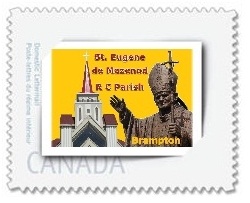
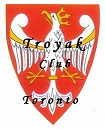
“TROYAK” CLUB NEXT MEETINGS …
NASTĘPNE SPOTKANIA KLUBU “TROYAK” …

23rd June 2019 @ 4:30 p.m.
July & August 2019 – Summer break … Letnie wakacje …

TROYAK CLUB @ Roncesvalles Polish Festival 2019
Saturday, September 14th … Sunday, September 15th, 2019
https://polishfestival.ca www.kazimierz.org
St. Casimir’s Church
Parish Hall … 156 Roncesvalles Ave. Toronto, Ontario
Stamp Exhibit … Pope John Paul II on World Stamps and
Displays of Coins, Stamps, Collectibles by Troyak Club Members.

29th September 2019
6th October 2019 @ 9:00 a.m. to 4:00 p.m. …
Mississauga’s Coin & Stamp Show 2019
27th October 2019; 24th November 2019

40. Rocznica utworzenia Instytutu Kardiologii im. Prymasa Tysiąclecia Stefana Kardynała Wyszyńskiego w Warszawie.
40th Anniversary of the establishment of Institute of Cardiology in Warsaw of name Prymas of Millenium Stefan Cardinal Wyszyński
www.poczta-polska.pl
Dnia 21 marca 2019 r. została wprowadzona do obiegu kartka pocztowa z nadrukowanym znakiem opłaty pocztowej, emisji: 40. rocznica utworzenia Instytutu Kardiologii im. Prymasa Tysiąclecia Stefana Kardynała Wyszyńskiego w Warszawie. Wartość nominalna znaku opłaty pocztowej z oznaczeniem literowym A odpowiada wartości nominalnej znaczka pocztowego używanego do uiszczenia opłaty za ekonomiczną przesyłkę listową nierejestrowaną, w tym kartkę pocztową, w obrocie krajowym, o masie do 350 g. W prawym górnym rogu strony adresowej kartki nadrukowano znak opłaty pocztowej, na którym przedstawiono wizerunek serca z tomografu komputerowego. W części ilustracyjnej kartki znajdują się: 1) znak Instytutu Kardiologii im. Prymasa Tysiąclecia Stefana Kardynała Wyszyńskiego w Warszawie, 2) widok sali operacyjnej. Kartkę o wymiarach 148 x 105 mm wydrukowano jednostronnie, techniką offsetową, na kartonie białym, w nakładzie 8000 sztuk. Autor projektu: Jacek Konarzewski.

40th Anniversary of the establishment of Institute of Cardiology in Warsaw of name Prymas of Millenium Stefan Cardinal Wyszyński … Denomination: 2,60 PLN … number of stationeries in set: 1; print run: 8.000 pcs; printing technique: offset; card size: 148 x 105 mm; release date: 21st March 2019; author: Jacek Konarzewski.

100. Rocznica przywrócenia relacji dyplomatycznych Polski i Stolicy Apostolskiej
100th Anniversary of the restoration of diplomatic relations between Poland and the Holy See
www.poczta-polska.pl
W dniu 29 marca 2019 r. został wprowadzony do obiegu znaczek pocztowy o wartości 5,00 zł emisji “100.rocznica przywrócenia relacji dyplomatycznych Polski i Stolicy Apostolskiej”. Znaczek wydrukowano techniką offsetową , na papierze fluorescencyjnym, w formacie znaczka 39,5 x 31,25mm , w nakładzie 240.000 sztuk. Arkusz zawiera 12 znaczków. Na znaczku przedstawiono wizerunek Marszałka Józefa Piłsudskiego i Papieża Benedykta XV na tle Belwederu i kopuły Bazyliki Świętego Piotra.Wzdłuż górnej krawędzi znaczka umieszczono napis: 100.rocznica przywrócenia relacji dyplomatycznych Polski i Stolicy Apostolskiej, w lewym górnym rogu umieszczono godło Polski a w górnym prawym rogu – godło Państwa Watykańskiego. Wzdłuż dolnej krawędzi znaczka umieszczono napis: Wspólna emisja Polski i Watykanu, miniaturę godła Polski oraz napis Polska i oznaczenie wartości 5 zł. Z tej okazji zostanie wydana również koperta FDC. Autor projektu znaczka: Stefano Morri. Arkusik emisji “100.rocznica przywrócenia relacji dyplomatycznych Polski i Stolicy Apostolskiej” wejdzie w skład abonamentu na arkusiki.
100th anniversary of the restoration of diplomatic relations between Poland and the Holy See … denomination: 5,00 PLN; number of stamps in set: 1; print run: 240.000 pcs.; printing techniques: offset; paper: fluorescent; stamp size: 39,5 x 31,25mm; 12 stamps in sheet; number of FDC: 1; author: Stefano Morri; circulation date: 29th March 2019.
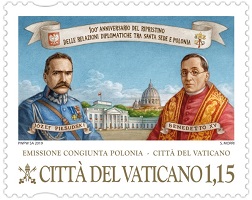
Wartość: 1,15 EUR … autor projektu znaczka: Stefano Morri;
liczba znaczków: 1; nakład: 60 000 szt.; technika druku: offset;
format znaczka: 39,5 x 31,25 mm; arkusz sprzedażny: 12 znaczków;
papier: fluorescencyjny; data wprowadzenia do obiegu: 29 marca 2019 r.
Wizerunek marszałka Józefa Piłsudskiego na tle Belwederu oraz papieża Benedykta V przy Bazylice św. Piotra w Watykanie przedstawia znaczek pocztowy wydany w związku z 100. rocznicą przywrócenia relacji dyplomatycznych Polski i Stolicy Apostolskiej. Znaczek o nominale 5 zł trafił do obiegu 29 marca br. Znaczek „100. rocznica przywrócenia relacji dyplomatycznych Polski i Stolicy Apostolskiej” to wspólne dzieło Poczty Polskiej i Watykańskiej. Nie mógłby powstać bez udziału Nuncjusza abp. Salvatore Pennacchio, Mauro Olivieri, dyrektora Biura Filatelistyczno-Numizmatycznego Państwa Watykańskiego. Autorem projektu znaczka jest Stefano Morri.
– Decyzja o wznowieniu stosunków dyplomatycznych między Polską a Stolicą Apostolską po wielu latach przerwy miała kluczowe znaczenie dla odradzającego się po okresie zaborów państwa polskiego. Nie bez znaczenia jest fakt, że Polska była istotnym europejskim państwem o większości katolickiej – czwartym co do wielkości w Europie po Francji, Włoszech i Hiszpanii oraz najistotniejszym takim państwem we wschodniej części Starego Kontynentu – mówi Przemysław Sypniewski, prezes zarządu Poczty Polskiej.
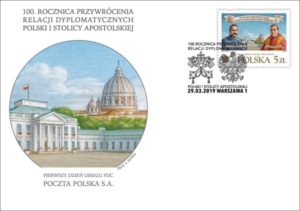
Papież Benedykt XV mianował 25 kwietnia 1918 r. prałata Achillesa Rattiego, ówczesnego prefekta Biblioteki Watykańskiej, wizytatorem apostolskim w Polsce. Hierarcha został uroczyście przywitany w Warszawie 30 maja 1918 r. Zaraz po przyjeździe ks. Ratti podjął swoją intensywną i wyczekiwaną misję kościelną i dyplomatyczną, co pokazują jego „Pamiętniki 1918–1919”, wydane przez Tajne Archiwum Watykańskie. 6 czerwca 1919 r., w następstwie przywrócenia relacji dyplomatycznych miedzy Polską i Stolicą Apostolską, prałat. Ratti został mianowany nuncjuszem apostolskim w Polsce. Drugi tom „Pamiętników 1919–1920” szczegółowo opisuje misję nuncjusza Rattiego, która zakończyła się 13 czerwca 1921 r., gdy został ustanowiony arcybiskupem Mediolanu. 2 lutego 1922 r. kardynał Ratti wszedł na konklawe, które miało wyznaczyć następcę papieża Benedykta XV. Cztery dni później, 6 lutego został wybrany papieżem i przyjął imię Pius XI.
Świadectwem jego głębokiej duchowości, charakteryzującej się pobożnością maryjną, była jego pielgrzymka do Częstochowy i Medal „X rocznicy Cudu nad Wisłą”. W odnowionej kaplicy w Pałacu Apostolskim w Castel Gandolfo, papież Pius XI umieścił ikonę Matki Bożej Częstochowskiej. W 1925 roku, zaledwie sześć lat po nawiązaniu stosunków dyplomatycznych z Watykanem, Polska podpisała konkordat.

100 lat Głównego Urzędu Miar
100 years of the Central Office of Measures
www.poczta-polska.pl
Dnia 01 kwietnia 2019 r. została wprowadzona do obiegu kartka pocztowa z nadrukowanym znakiem opłaty pocztowej, emisji: 100 lat Głównego Urzędu Miar. Wartość nominalna znaku opłaty pocztowej z oznaczeniem literowym A odpowiada wartości nominalnej znaczka pocztowego używanego do uiszczenia opłaty za ekonomiczną przesyłkę listową nierejestrowaną, w tym kartkę pocztową, w obrocie krajowym, w formacie S o masie do 500 g. W prawym górnym rogu strony adresowej kartki nadrukowano znak opłaty pocztowej, na którym przedstawiono wizerunek twórcy polskiej administracji miar i pierwszego dyrektora Głównego Urzędu Miar, dr h.c. inż. Zdzisława Erazma Rauszera; w prawym dolnym rogu znaczka umieszczono oznaczenie wartości: A oraz napis: POLSKA. W części ilustracyjnej kartki znajduje się plakat przygotowany na obchody 100-lecia Głównego Urzędu Miar, autorstwa R. Szaybo, oraz logotyp Urzędu. Kartkę o wymiarach 148 x 105 mm wydrukowano jednostronnie, techniką offsetową, na kartonie białym, w nakładzie 8000 sztuk. Autor projektu: J. Ochendzan.
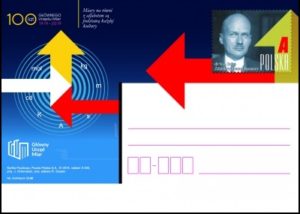
100 years of the Central Office of Measures … denomination: 3,30 PLN;
number of stationeries in set: 1; print run: 8.000 pcs;
printing technique: offset; card size: 148 x 105 mm
release date: 01st April 2019; author: J. Ochendzan.

100. Rocznica odnowienia polsko-francuskich stosunków dyplomatycznych
100th Anniversary of the restoration of Polish-French diplomatic relations
www.poczta-polska.pl
Wartość: po 5 zł każdy … autor projektów: Maciej Jędrysik;
liczba znaczków: 2 w bloku; nakład: po 120 000 szt. Każdego;
technika druku: offset; format znaczka: 31,25 x 43 mm;
format bloku: 121 x 75 mm; arkusz sprzedażny: 2 znaczki;
papier: fluorescencyjny; data wprowadzenia do obiegu: 2 kwietnia 2019 r.

100th Anniversary of the restoration of Polish-French diplomatic relations …
denomination: 5,00 PLN; number of stamps in set: 2;
print run: 120.000 pcs.; printing techniques: offset;
paper: fluorescent; stamp size: 31,25 x 43 mm block: 121 x 75 mm;
2 stamps in block; circulation date: 02nd April 2019;
number of FDC: 1; author: Maciej Jędrysik.

100. Rocznica powstania Polskiego Towarzystwa Matematycznego
100th Anniversary of the Polish Mathematical Society
www.poczta-polska.pl
Dnia 02 kwietnia 2019 r. została wprowadzona do obiegu kartka pocztowa z nadrukowanym znakiem opłaty pocztowej, emisji: 100. rocznica powstania Polskiego Towarzystwa Matematycznego. Wartość nominalna znaku opłaty pocztowej z oznaczeniem literowym A odpowiada wartości nominalnej znaczka pocztowego używanego do uiszczenia opłaty za ekonomiczną przesyłkę listową nierejestrowaną, w tym kartkę pocztową, w obrocie krajowym, w formacie S o masie do 500 g. W prawym górnym rogu strony adresowej kartki nadrukowano znak opłaty pocztowej, na którym przedstawiono znak graficzny obchodów 100. rocznicy powstania Polskiego Towarzystwa Matematycznego (PTM), z symbolicznym rysunkiem wieży Kościoła Mariackiego w Krakowie, nawiązującym do miejsca powołania Towarzystwa; w prawym górnym rogu znaczka umieszczono oznaczenie wartości: A, a w lewym górnym rogu – napis POLSKA.
W części ilustracyjnej kartki znajduje się nazwa emisji ,,100. rocznica powstania Polskiego Towarzystwa Matematycznego” oraz: *- archiwalna fotografia gmachu Collegium Nowodworskiego Uniwersytetu Jagiellońskiego, gdzie 2 kwietnia 1919 roku powołano Krakowskie Towarzystwo Matematyczne, przekształcone następnie w Polskie Towarzystwo Matematyczne; na tle zdjęcia umieszczono fragment protokołu z zebrania założycielskiego, *- współczesna fotografia budynku przy ul. Śniadeckich 8 w Warszawie, obecna siedziby PTM, a na jej tle protokół z ostatniego posiedzenia Zgromadzenia Delegatów PTM, z 16 czerwca 2018 roku, *- rysunek przedstawiający jedno z bardzo ważnych osiągnięć polskiej matematyki okresu międzywojennego – Continuum dziedzicznie nierozkładalne (continuum Knastera), – ilustracja twierdzenia retraktowego Ważewskiego, uznawanego za jeden z ważniejszych wyników w równaniach różniczkowych po II wojnie światowej. Kartkę o wymiarach 148 x 105 mm wydrukowano jednostronnie, techniką offsetową, na kartonie białym, w nakładzie 8000 sztuk. Autor projektu: Jan Konarzewski. Koncepcja graficzna: WuKaDeM.
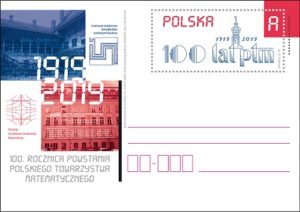
100th Anniversary of the Polish Mathematical Society …
denomination: 3,30 PLN; number of stationeries in set: 1;
print run: 8.000 pcs; printing technique: offset;
card size: 148 x 105 mm; release date: 02nd April 2019;
author: Jan Konarzewski.

Wyprawa wileńska
www.nbp.pl
Narodowy Bank Polski jest centralnym bankiem państwa odpowiadającym za politykę pieniężną i stabilność cen. Jego funkcje określa Konstytucja Rzeczypospolitej Polskiej i ustawa o NBP. NBP ma wyłączne prawo emisji pieniądza. Jako bank centralny nie prowadzi rachunków bankowych obywateli, nie przyjmuje od nich lokat, nie udziela kredytów. Prowadzi natomiast obsługę budżetu państwa, a także podmiotów sektora finansów publicznych. Gromadzi rezerwy walutowe państwa i zarządza nimi. Pełni funkcję banku banków, tworząc warunki do działania systemu bankowego. Jest również jednym z najważniejszych ośrodków naukowo-analitycznych w dziedzinie ekonomii i rynków finansowych. 21 marca 2019 roku Narodowy Bank Polski wprowadził do obiegu srebrną monetę o nominale 10 zł „Wyprawa wileńska”.
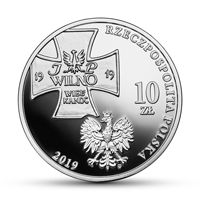
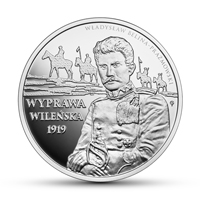
Nominał 10 zł … metal: Ag 925/1000; stempel: lustrzany;
średnica: 32,00 mm; masa: 14,14 g; brzeg (bok): gładki;
nakład: do 13 000 szt.; Projektant: Grzegorz Pfeifer;
Emitent: NBP Na zlecenie NBP monety wyprodukowała
Mennica Polska S.A.; Wizerunek Władysława Beliny-Prażmowskiego,
wg zdjęcia pochodzącego ze zbiorów Narodowego Archiwum Cyfrowego.
Operacja wileńska została zaplanowana i przeprowadzona przez Józefa Piłsudskiego w kwietniu 1919 r. wbrew opinii polskich i francuskich sztabowców, wróżących jej klęskę. Naczelny Wódz pragnął uprzedzić spodziewaną ofensywę bolszewików, którzy koncentrowali wojska za Niemnem, aby uderzyć na organizujące się dopiero państwo polskie i przekształcić je w republikę rad. Część polskich sił zaatakowała Nowogródek, Baranowicze i Lidę, ściągając na siebie uwagę nieprzyjaciela. Pod ich osłoną 16 kwietnia ruszyła na Wilno grupa złożona z brygady jazdy ppłk. Władysława Beliny-Prażmowskiego i kilku batalionów piechoty gen. Edwarda Rydza Śmigłego. Jazda Beliny wyprzedziła piechotę i, przemieszczając się lasami, o świcie 19 kwietnia zaskoczyła silny garnizon bolszewicki w Wilnie. Przy wsparciu ludności opanowano część miasta. Nieprzyjaciel ochłonął z zaskoczenia i wywiązały się ciężkie walki uliczne. Wieczorem, kiedy kawalerii kończyła się amunicja, do Wilna przyjechał zdobytym pociągiem batalion 1. pułku piechoty Legionów. O zwycięstwie przesądziło przybycie, nocą z 20 na 21 kwietnia, głównych sił polskiej piechoty.
Przed południem 21 kwietnia opanowano całe miasto. Dla bolszewików utrata Wilna była wielką porażką propagandową i wojskową. W Polsce wiadomość o oswobodzeniu miasta wywołała wybuch radości. W sukcesie tym upatrywano zapowiedź przyszłego zwycięstwa w wojnie z Rosją bolszewicką. Zagon kawalerii Beliny na Wilno został uznany za jeden z najpiękniejszych czynów jazdy polskiej w wojnach lat 1919−1920. Na rewersie monety, na tle kawalerii maszerującej na Wilno, przedstawiono wizerunek płk. Władysława Beliny-Prażmowskiego, nazywanego pierwszym ułanem Drugiej Rzeczypospolitej. Był legionistą, organizatorem i dowódcą 1. pułku ułanów Legionów Polskich; w niepodległej Polsce zorganizował 1. Brygadę Jazdy, którą dowodził w latach 1919−1920. Jesienią 1920 r. na własną prośbę odszedł z wojska. W latach 1931−1933 był prezydentem Krakowa, a następnie do 1938 r. wojewodą lwowskim. Na awersie umieszczono wizerunek wojskowej odznaki pamiątkowej nadawanej w okresie międzywojennym uczestnikom wyprawy na Wilno. Informacja: prof. Janusz Odziemkowski.

Vilnius Offensive
www.nbp.pl
Narodowy Bank Polski is the central bank of the State, responsible for its monetary policy and price stability. The Bank’s functions are described in the Constitution of the Republic of Poland and the Act on NBP. NBP holds the exclusive right to issue the currency of the Republic of Poland. As the central bank, it does not provide accounts for the general public, accept deposits from or extend loans to individuals. It acts as a banker to the State budget and public sector entities. NBP also holds and manages the foreign exchange reserves of the State. Finally, it functions as a banker to banks, creating conditions for the operation of the Polish banking system. Narodowy Bank Polski is one of the most important research and analytical centres in the fields of economics and financial markets. On 21 March 2019, Narodowy Bank Polski issued into circulation a silver coin “Vilnius Offensive” with a face value of 10 złoty.


Face value: 10 zł … Metal: Ag 925/1000; Finish: proof; Diameter: 32.00 mm;
Weight: 14.14 g; Edge (side): plain; Mintage: up to 13,000 pcs;
Designer: Grzegorz Pfeifer; Issuer: NBP; The coins, commissioned by NBP,
were struck by Mennica Polska S.A. The image of Władysław Belina-Prażmowski
is based on a photograph taken from the collection of the National Digital Archives.
The Vilnius operation was planned and launched by Józef Piłsudski in April 1919 contrary to the opinion held by the Polish and French military staff, who foretold its failure. The Commander-in Chief hoped to forestall the expected offensive by the Bolsheviks, who were concentrating their troops beyond the Neman to hit the Polish state, which was only just organizing itself, and to transform it into a soviet republic. Part of the Polish forces attacked Navahrudak, Baranavichy, and Lida, thus catching the attention of the enemy. Under their cover, a group made up of a cavalry brigade commanded by Lieutenant Colonel Władysław Belina-Prażmowski and several infantry battalions led by General Edward RydzŚmigły advanced on Vilnius on 16 April. Belina’s cavalry overtook the infantry and, moving through the woods, caught the strong Bolshevik garrison in Vilnius by surprise at dawn on 19 April. With the support of the local people, part of the city was seized. The enemy recovered from the surprise, and heavy street fighting broke out. In the evening, when the cavalry was running out of ammunition, a battalion of the 1st Infantry Regiment of the Polish Legions arrived in Vilnius on a captured train.
Victory was secured by the arrival of the main forces of the Polish infantry on the night of 20 to 21 April. By noon on 21 April, the entire city was captured. For the Bolsheviks, losing Vilnius was a great propagandistic and military failure. In Poland, the news of the city’s liberation triggered an explosion of joy. The success was seen as a promise of a future victory in the war against Bolshevik Russia. The foray of Belina’s cavalry to Vilnius was considered one of the most beautiful actions of the Polish cavalry in the wars of 1919−1920. The reverse of the coin features an image of Lieutenant Colonel Władysław Belina-Prażmowski, dubbed the first uhlan of the Second Republic of Poland, against the background of the cavalry marching to Vilnius. He was a legionnaire and the organizer and commander of the 1st Uhlan Regiment of the Polish Legions; he organized the 1st Cavalry Brigade in independent Poland, which he commanded in the years 1919−1920. In the autumn of 1920, he left the army at his own request. In the years 1931−1933, he was the Mayor of Cracow, and then the Voivode of the Lvov Province until 1938. The obverse carries an image of a military commemorative badge awarded to the participants of the Vilnius expedition in the interwar period. Info: Prof. Janusz Odziemkowski.

Quebec Winter Carnival
www.canadapost.ca
https://postagestampguide.com
“The only talking snowman in the world”, Bonhomme Carnival, presides over the Quebec Winter Carnival, the “Mardi Gras of the North”. As king of the three-week festival, this amiable snowman has the power to arrest anyone who does not display the proper spirit for a time of merriment. Quebec’s first winter carnival was held in 1894 but festivities were discontinued after the turn of the century. The modern carnival, a far cry from its ancestor, was inaugurated in 1954. Highlights of the festival, climaxed on Mardi Gras, the day before Ash Wednesday, include contests, ice canoe races, costume balls, and ice and snow sculptures.
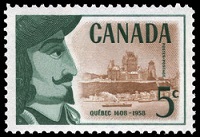
Denomination: 5¢ … Perforation or Dimension: 12;
Quantity: 19,910,000; Date of Issue: June 26, 1958;
Printer: Canadian Bank Note Company, Limited.
About Stamp … Quebec City, the capital of the province of Quebec is situated at the junction of the St. Lawrence and St. Charles rivers. Modern Quebec consists of the Lower Town which is distinctly European in its appearance and the Upper Town, built on the higher land overlooking the St. Lawrence. Although Cartier saw the site in 1535 he did not establish a settlement; Champlain founded the community as a trading post in 1608. The city has a varied background with the British as captors in 1629. It was returned to the French in 1632. The British failed to capture the city in 1690, but under General Wolfe leading British forces in 1759 during the Seven Years War, Quebec fell. It was formally ceded to Britain in 1763. Interesting Detail … The designer’s initial can be found in the bottom-left corner of the stamp. The initial GT, which has a rather unique look, belongs to Gerald Mathew Trottier. Designed by Gerald Mathew Trottier. Picture engraved by Yves Baril. Lettering engraved by Gordon Mash.
Quebec, 1958 … The stamp features a large head of a man, at the left, to represent Champlain. (No authentic likeness of Champlain exists.) A view of Quebec in 1958 displays both the Upper and Lower towns with the St. Lawrence River in the foreground.

Denomination: 6¢ … Perforation or Dimension: 12;
Quantity: 175,800,000; Date of Issue: October 6, 1971;
Printer: Canadian Bank Note Company, Limited.
Designed by Lisl Levinsohn.

Denomination: 7¢ … Perforation or Dimension: 12;
Quantity: 114,500,000; Date of Issue: October 6, 1971;
Printer: Canadian Bank Note Company, Limited.
Designed by Lisl Levinsohn.
About Stamp … Snowflakes, tiny gossamer crystals whose myriad variety of forms defy man’s efforts to find and identical pair, provided the inspiration for designs on 1971 Canadian Christmas stamps. This is the eighth consecutive year in which the Canada Post Office has produced special issues for use on the nation’s Christmas mail. Through centuries of time, men and women have responded to the infinite beauty of snow. Some, amidst the hush of a winter storm, have recalled the words of the Lord in The Book of Job (Verse 22, Chapter 38) – “Hast thou entered into the treasures of the snow? or hast thou saw the treasure of the hail.” Many have devoted virtually all of their lives to analysing and classifying snow crystals. With photographs or drawings, they have recorded their findings for the information of others. Here, too, the inherent ingenuity and inquisitiveness of man come into focus in the development of a technique that permits the trapping of snow crystals between thin layers of fast-setting plastic to preserve forever their beauty in the form of a permanent cast. Harmless in the palm of the hand, fragile and delicate snow crystals, by sheer volume and weight, can paralyse modern communities as they fall in countless millions. Offsetting any disadvantages of the snows, the people’s health, and the nation’s economy gain from a mushrooming snow-sport industry that capitalizes on a phenomenon of nature to which there is not such easy access in many parts of the world. The vast reaches of Canada include areas of comparatively little precipitation in the form of snow.
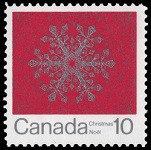
Denomination: 10¢ … Perforation or Dimension: 12;
Quantity: 12,300,000; Date of Issue: October 6, 1971;
Printer: Canadian Bank Note Company, Limited.
Designed by Lisl Levinsohn.
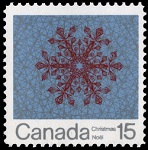
Denomination: 15¢ … Perforation or Dimension: 12;
Quantity: 19,025,000; Date of Issue: October 6, 1971;
Printer: Canadian Bank Note Company, Limited.
Designed by Lisl Levinsohn.
Most regions receive moderate to very heavy snowfalls, the latter including interior areas of British Columbia where the yearly average approaches thirty feet. Snowflake designs reproduced on the 1971 Christmas issues are creations of Miss Lisl Levinsohn, of Toronto, whose intricate pen drawings are considered by many among the best of the kind in the world. In reproducing the snowflake designs, the contemporary style and fine delineation of the line have been preserved by special attention to printing techniques. The lower denominations are examples of creating a reverse image through the use of engraving. Higher values employ the technique of engraving to superimpose lines of silver ink upon a ground and field printed in two colours by the lithographic process. Responding to the potential serenity of life on the shores of Lake Ontario, Miss Levinsohn emigrated to Canada in 1964 from the United States where she had lived after leaving her native Vienna, Austria, as a young child in 1937. Prior to adopting Canada as her home, professional figure skating, advertising, drafting, designing, and mathematics had occupied her time, principally in the New York area. Although youthful aspirations pointed her to a career in writing, two years after leaving the United States she began to produce the drawings, frequently consisting of some sixty-seven thousand carefully plotted lines, which have since gained international recognition. (42-VI-19)

Sweet Canada: PermanentTM Domestic stamps – Booklet
www.canadapost.ca
We’re serving up huge helpings of Canadian culinary history with our Sweet Canada stamp issue. This booklet of 10 PermanentTM domestic stamps dishes up the origins of five delicious Canadians desserts and takes you on a tasty trip from coast to coast. The featured desserts are Nanaimo bars, Saskatoon berry pie butter tarts, tarte au sucre (sugar pie) and blueberry grunt. The fun-shaped stamps are arranged on a recipe card background. The back of the booklet also features a recipe box motif. Rich and chocolatey Nanaimo bars have been associated with their namesake Vancouver Island city since the no-bake recipe first appeared there in the 1950’s. Saskatoon berry pie, notable for the unique apple and almond taste of its fruit, is a true Canadian original. High in fibre, protein and antioxidants, the berries were once a staple of Indigenous people and Prairie settlers. Butter tarts have become an object of cultural pride in some Canadian communities, with several Ontario towns boasting the best bakers of these sweet pastries. An indispensable offering at Quebec patisseries, tarte au sucre has centuries-old European origins that were adopted by early arrivals to New France. Named for the noise it makes while cooking, blueberry grunt has been enjoyed on Canada’s East Coast for generations.
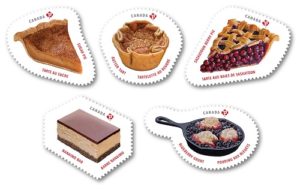
Stamp value: PermanentTM (domestic rate); Issue date: April 17, 2019;
Stamp designer: Roy White, Liz Wurzinger, Subplot Design Inc.;
Illustration: Mary Ellen Johnsonn; Quantity products: 200,000;
Dimensions: Sugar Pie: 34.4 mm x 30.5 mm;
Butter tart: 32 mm x 29.4 mm; Saskatoon Berry Pie: 40.9 mm x 30.9 mm;
Nanaimo Bar: 35.1 mm x 32 mm; Blueberry Grunt: 43.1 mm x 27.9 mm.
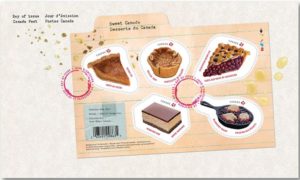
Sweet Canada: Souvenir Sheet Official First Day Cover … Dig into the delicious origins of five famous Canadian desserts with this fun and colourful Official First Day Cover, part of our Sweet Canada issue. Quantity products: 7,000; Dimensions: 190 mm x 112 mm.

2019 … Pure Silver 7-Coin Proof Set
– 75th Anniversary of D-Day
www.canadapost.ca www.mint.ca

They carried the weight of history with them. On June 6, 1944, about 14,000 Canadians stormed Juno Beach during the Allied landings in Normandy. Coming under heavy enemy fire, Canadian forces advanced farther inland that day than any other Allied landing force—but success on D-Day was only the beginning of a longer, hard-fought campaign. Your seven-piece pure silver proof set features an exclusive gold-plated version of the 2019 Proof Dollar, which commemorates the 75th anniversary of D-Day by putting a touchingly human face on a key historic event.
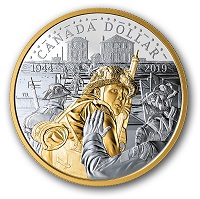
Proof dollar design: Designed by Tony Bianco, your proof dollar steps back in time to the morning of June 6, 1944, as the first wave of Canadian troops storms Juno Beach. The scene shares the same inspiration as the Juno Beach Centre Association’s D-Day anniversary logo; it re-creates a moment caught on film when the North Shore (New Brunswick) Regiment landed on Nan Red Beach (La Rive Plage). Highlighted by selective gold plating, an infantry soldier has a strained expression on his face after surveying what lies ahead—this is his first real combat experience. A reassuring pat is a touching moment of humanity and a gesture of solidarity amid enemy fire and fear, while the wedding ring is a reminder of loved ones back home. In the sky above, a sequence of dots and dashes represent the letter V (for “Victory”) in Morse code; they allude to the radio broadcasts that announced the Allied landings that day. The reverse includes the word “CANADA”, the double dates “1944” and “2019”, and the face value “DOLLAR”. The obverse features the effigy of Her Majesty Queen Elizabeth II by Susanna Blunt.

2019 … $3 Pure Silver Coin Set – The Elements
www.canadapost.ca www.mint.ca
Fire, air, earth, and water… This set of 4 square-shaped coins marks the first time we’ve ever highlighted the Four Elements. And true to form, there’s a Canadian twist: colourful maple leaves. Coming together to complete a circle that represents the past, present, and future, each quadrant shows these powerful forces of nature at work—from the chinook wind to our mighty rivers. A powerful first impression. From the moment you open the case, you’ll see the completed design. All four coins come individually encapsulated and securely in place in a custom recessed insert, which allows you to view and display them as a set. Exceptional details. The carefully sculpted design is rich in detail, with different frostings that transform an etched image into a dynamic piece of art. A touch of colour. In all four corners of the completed design, maple leaves appear in their seasonal colours (red, gold, brown and green).
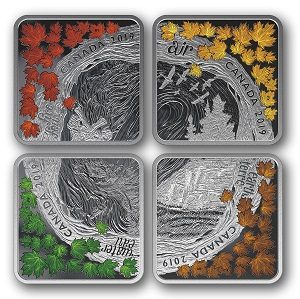
Face value: 3 dollars each … Composition: 99.99% Pure Silver;
Mintage: 2,000; Weight: 11.72 g; Diameter: 27 mm x 27 mm;
Finish: Proof with colour; Artist: Rebecca Yanovskaya.
They are the four elements that were believed by the ancient Greeks to be the pillars of life: Earth, grounding and nourishing; Air, always in motion; Fire, provider of heat and light; and Water, constantly flowing. They are the cornerstones of our natural world. And they are especially significant in a nation like ours, with an identity that is so strongly tied to nature. This four-coin set is an original concept proposed by a long-time collector and Masters Club member, Bernard Dumais. Its design is a Canadian take on the four elements, complete with maple leaves. And like a four-part image, each square coin comes together to illustrate how these elemental forces of nature have all shaped Canada’s past, present, and future—from the warm chinook to our flowing rivers, and a burning sense of pride for it all.
“With my submission, I wanted to propose a theme that would truly represent Canada and its natural strengths. I was inspired by the four elements that have shaped our past, present, and future: earth, air, fire and water. As a collector and proud ambassador of Mint products, I am tremendously honoured to have been able to contribute to the creation of this set.”
Design: Designed by artist Rebecca Yanovskaya, your four-part image ties together the four elements within a circle that represents a continuous circle—Canada’s past, present, and future. Each square coin features a quadrant named (in English and in French) for elemental energy, with all four elements bleeding into the other:
“FIRE FEU” features the comforting glow of a campfire that symbolizes heat and light, with maple leaf-shaped flames that represent pride burning in the hearts of Canadians.
“AIR” is represented by the warm chinook that descends the eastern slopes of the Rocky Mountains, and the winds that provide lift for our migratory bird species.
“EARTH TERRE” features the forests, rocks, and fields that are the foundation of this land.
“WATER EAU” is represented by a fast-flowing river filled with salmon to symbolize the fisheries.
The completed circle is framed by red, gold, brown, and green-coloured maple leaves, the beloved symbol of Canada. Each reverse includes the engraved word “CANADA” and the year “2019”. Each obverse features the face value “3 DOLLARS” and the effigy of Her Majesty Queen Elizabeth II by Susanna Blunt.
Did you know…
Earth … Some of Earth’s oldest rocks, the Canadian Shield represents nearly 50 percent of Canada’s total landmass. The Shield is rich in natural resources, from minerals to forests; in fact, forests cover 35% (or 3,470,690 km2) of Canada’s total area (9,984,670 km2).
Water … Surrounded by three oceans, Canada has the world’s longest coastline (243,042 km) and a rich fishing tradition. Beyond the coasts, Canada is a freshwater-rich country: our many rivers, waterways, and lakes represent about 20% of the world’s fresh water (7% of the world’s renewable freshwater). Our deepest lake is Great Slave Lake (N.W.T.), which is where our longest river, the Mackenzie River, begins.
Fire … The campfire on the coin symbolizes pride, and the pride that burns within us. Though Canada isn’t known for volcanic eruptions, our Pacific coast is part of the famous Ring of Fire. In fact, British Columbia and Yukon are home to a few volcanoes, including Mounts Garibaldi, Edziza and Mount Meager. Most Canadians tend to associate fire with winter warmth and time spent outdoors.
Air/Wind … Chinook means “snow eater.” It refers to a class of strong winds called foehn that blow warm and dry in descending a mountain slope. Chinooks often occur over the western plains of North America but are at their greatest strength in southwestern Alberta, where they funnel through Crowsnest Pass and fan out across southern Alberta, with a diminishing effect as they cross into Saskatchewan. The arrival of a chinook wind, with its typical arch of low cloud in the western sky paralleling the Rockies, brings mixed blessings to residents of southern Alberta. While it may bring a welcome touch of spring and temporary relief from the bitter cold of winter, a few are bothered by debilitating reactions ranging from sleeplessness to migraines, disrupted skiing conditions to thawed backyard skating rinks. On the other hand, what Albertan wouldn’t favour golfing in January and seeing lilacs before spring. Info: — David Phillips, Senior Climatologist, Environment and Climate Change Canada.

2019 … $10 Pure Silver Coin – EQUALITY
www.canadapost.ca www.mint.ca
Over the last five decades, Canada has made significant strides in becoming a more inclusive society, guided by a belief in diversity, equality for all and the right to live free from discrimination, regardless of sexual orientation, gender identity, gender expression or sex characteristics. On April 23rd, 2019, commemorate 50 years since Canada took the first step towards decriminalizing being gay. The double dates “1969” and “2019” set the tone for a continuing conversation about fundamental freedoms in Canada. It highlights how far we, as a country, have come in terms of promoting and supporting equal rights, and how we must still strive to eliminate discrimination and bias.
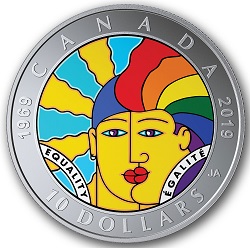
Face value 10 dollars … Composition: 99.99% pure silver;
Mintage:15,000; Finish: matte proof; Weight: 15.87 g;
Diameter: 34 mm; Edge: serrated; Certificate: serialized;
Artist: Joe Average (reverse), Susanna Blunt (obverse).
Design: The reverse image by Canadian artist Joe Average is a celebration of community, equality and inclusion. The intertwined stylization invites a personal interpretation of the design, viewed through the lens of sexual orientation, gender identity, gender expression and sex characteristics. The facial traits reflect gender fluidity and the spectrum of gender expression; they may belong to two individuals, or they may represent different aspects of one’s identity. A ray of light reflects in each eye and brings the colour image to life, bolstered by the vibrant colours of the PRIDE flag. The English word “EQUALITY” and the French word “ÉGALITÉ” are included on two curved bands. The frame includes the word “CANADA”, the double dates “1969” and “2019” to mark the 50 years since the process of decriminalizing being gay in Canada began, and the face value, “10 DOLLARS”. The obverse features the effigy of Her Majesty Queen Elizabeth II by Susanna Blunt.

2019 … $1 EQUALITY Special Wrap Roll
www.canadapost.ca www.mint.ca
Over the last five decades, Canada has made significant strides in becoming a more inclusive society, guided by a belief in diversity, equality for all and the right to live free from discrimination, regardless of sexual orientation, gender identity, gender expression or sex characteristics. Our 2019 EQUALITY circulation dollar is a special celebration of the commemoration of diversity, and the journey to inclusion; of the freedom to love and be loved, a journey that continues to this day. This year we commemorate the 50th Anniversary of the Decriminalization of being gay with this special $1 Coin roll.
Design: The reverse image by Canadian artist Joe Average is a celebration of community, equality and inclusion. The intertwined stylization invites a personal interpretation of the design, viewed through the lens of sexual orientation, gender identity, gender expression and sex characteristics. The facial traits intentionally reflect gender fluidity and the spectrum of genders; they may belong to two individuals, or they may represent different aspects of one’s identity. The maple leaf security feature is positioned over hopeful rays of light, while the bilingual words “EQUALITY” and “ÉGALITÉ” are engraved on two curved bands. The reverse includes the word “CANADA”, the double dates “1969” and “2019” to mark the 50 years since the process of decriminalizing being gay in Canada began, and the “DOLLAR” face value. The obverse features the effigy of Her Majesty Queen Elizabeth II by Susanna Blunt.
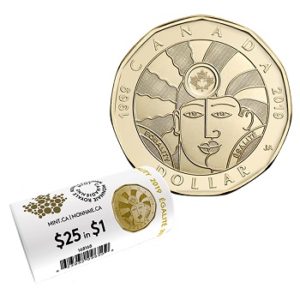
Face value: 1 dollar … Composition: three-ply brass plated steel;
Mintage:15,000 rolls of 25 coins; Finish: circulation; Weight: 6.27 g;
Diameter: 26.5 mm; Edge: plain; Certificate /a;
Artist: Joe Average (reverse), Susanna Blunt (obverse).
Equally free to love, to be… A full-colour version of our 2019 EQUALITY circulation dollar, this pure silver coin commemorates the 50th anniversary of an important landmark for LGBTQI2 rights in Canada. The upbeat, colourful design by Joe Average is more than an expression of pride and community — it reflects on the decades-long struggle to advance equal rights for Canada’s LGBTQI2 communities, and the hard-fought freedom to live, love and be. An inspirational message that re-affirms Canada’s commitment to human rights and reflects on our journey towards equality, diversity and inclusivity. A show of pride for a diverse and inclusive Canada: An inspiring statement of support for social progress in Canada, and the hard-fought gains in sexual and gender rights. A matte proof finish gives the coin a strong frosted appearance that emphasizes the crisp impression on its reverse. A Joe Average original: The thought-provoking design by Vancouver-based artist Joe Average invites viewers to interpret the art in their own way, to reflect their story and experiences.

Roncesvalles Polish Festival
https://polishfestival.ca
www.kazimierz.org
www.troyakclub.com
The 2019 Roncesvalles Polish Festival, North America’s largest celebration of Polish culture in Toronto’s best neighbourhood, Roncesvalles Village! will be taking place September 14th and 15th, 2019. Now entering its fourteenth year, the Festival adds an old world charm to today’s Roncesvalles Village, well-known as one of Toronto’s most vibrant, diverse and creative communities. Enjoy great local and international music, including Polish folklore, Polka and Euro dance bands, and entertainment from near and far on multiple stages. Saturday night enjoy the ever-popular Disco Polo Party. Come out and sample fantastic cuisine from over 40 renowned restaurants, cafes, bakeries, and bistros, along Roncesvalles, and of course, lots of traditional Polish fare, including pierogi, kielbasa, bigos, cabbage rolls, and much much more!

Saturday, September 14th, 2019 … Festival Hours: 11:00am to 11:00pm
Sunday, September 15th, 2019 … Festival Hours: 11:00am to 7:00pm
Discover treasures along the 18 blocks of boutique shops and merchants. We also have a Car Show and many great vendors with unique products and food. The Roncesvalles Polish Festival is easy to get to by transit and car, family-friendly and free, with lots of entertainment for kids, families, and adults, including two midway areas, three stages with continuous entertainment, two giant beverage gardens, and of course the wonderful offerings of Roncesvalles Village’s restaurants and merchants. Find out what over 300,000 people discovered last year: nobody knows how to party quite like us! See you at the Roncesvalles Polish Festival!

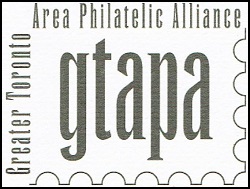
www.gtapa.org
The GTAPA is committed to promote and stimulate the art of philately
to all ages for fun, culture, education and friendship.

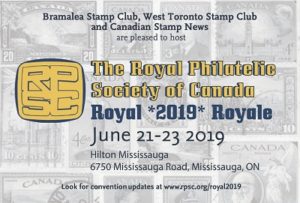
Royal *2019* Royale
www.rpsc.org/royal2019
The West Toronto Stamp Club, Bramalea Stamp Club and Canadian Stamp News are co-hosting Royal *2019* Royale. The June 21-23 convention will be held at the classy Hilton Mississauga on 6750 Mississauga Road. The next annual general meeting (AGM) of The Royal Philatelic Society of Canada (RPSC) will be held on the morning of June 22 during the society’s 91st convention in Mississauga, Ontario. The aim of the AGM, which will be held at the Hilton Mississauga/Meadowvale, is for members to receive and consider reports from executive members, directors and duty officers as well as the society’s financial statements as of Dec. 31. Members will also consider – and if approved, ratify, sanction and confirm – all by-laws, contracts, acts and proceedings of The RPSC’s board of directors enacted since the last AGM. There will also be an election of seven directors. The 2019 election of director positions will be decided by secret ballots submitted by members of the society.

